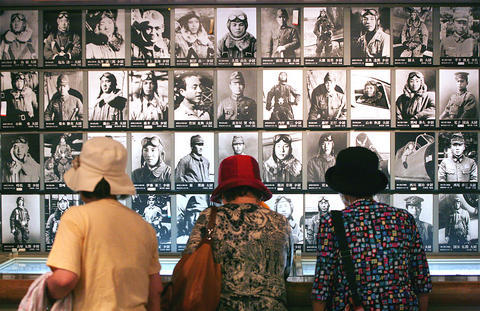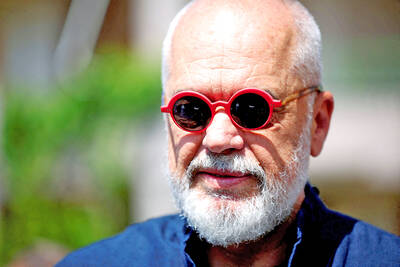On April 12, 1945, Lieutenant Shinichi Uchida faced a terrifying mission -- crash his plane into a US warship. But the young kamikaze's final letter to his grandparents was full of bravado.
"Now I'll go and get rid of those devils," the 18-year-old wrote shortly before his final flight, vowing to "bring back the neck" of President Franklin Roosevelt. He never returned.
For many, such words are redolent of the militarism that drove Japan to ruin in World War II. But for an increasingly bold cadre of conservatives, Uchida's words symbolize something else: just the kind of guts and commitment that Japanese youth need today.

PHOTO: AP
Long a synonym for the waste of war, the suicidal flyers are now being glorified in a film written by Tokyo Governor Shintaro Ishihara, a well-known nationalist and co-author of the 1989 book The Japan That Can Say No. And a museum about the kamikazes in the southern town of Chiran, near the airstrip where Uchida and others took off, gets more than 500,000 visitors a year.
"The worries, sufferings, and misgivings of these young people ... are something we cannot find in today's society," Ishihara said when his movie, I Go to Die For You, opened this spring.
"That is what makes this portrait of youth poignant and cruel, and yet so exceptionally beautiful," he said.
No one is publicly calling for young Japanese to kill themselves for the nation these days. But the renewed hero-worship of the kamikazes coincides with a general trend in Japanese society toward seeing the country's war effort as noble, and mourning the fading of the ethic of self-sacrifice amid today's wealth.
The government has stepped up efforts to expunge accounts of Japanese atrocities from history books and reinstate patriotic instruction in the public schools. Prime Minister Shinzo Abe, like his popular predecessor, Junichiro Koizumi, is pushing to revise the pacifist Constitution.
The estimated 4,000 kamikaze -- or "divine wind" -- pilots were named after a legendary typhoon that foiled the Mongol emperor Kublai Khan's invasion of Japan in 1281. Chiran museum officials say as many as 90 percent failed to reach the US warships they were meant to attack.
Despite the pilots' reputation abroad as suicidal fanatics, Japanese hearts have always had a soft spot for the kamikazes. Long celebrated in movies, books and comic books, the pilots are seen as innocent young men forced by a desperate military into sacrificing their lives to protect their country.
Ishihara's film plays these tragic-hero sentiments to the hilt, with a strong dose of patriotism: Strapping young pilots proudly sing war songs and down cups of sake before taking off, while townspeople kneel in tearful gratitude as they fly overhead. Girls paint Rising Sun flags with their own blood.
The film is set in Chiran, about 1,000km southwest of Tokyo. From here 402 pilots took off, among them Uchida, whose fate remains unknown.
Today's kamikaze-boosters deny they are pro-war, and indeed, the Ishihara film does not shy away from the futility of the suicide missions. But the nationalist sentiment is clear.
While insisting to reporters that the movie's message is anti-war, director Taku Shinjo said Japan launched the war in Asia in self-defense, and that the decision to send young men on suicide missions was the only option left as the conflict neared its end.
"When you get to the roots of the Japanese soul, I think they are embodied in the kamikaze pilots," he said.
While the Japanese have not fired a shot in wartime since 1945, critics see peril in the new trend.
"It's extremely dangerous to glorify the kamikaze pilots as tragic heroes. The people who glorify them want to connect the prewar period with the present and future Japan," said Atsushi Shirai, a historian who has written about the pilots.
"These views also block critical analysis of the tragedy of the war, what it signified and why it was carried out," he added.

FRAUD ALLEGED: The leader of an opposition alliance made allegations of electoral irregularities and called for a protest in Tirana as European leaders are to meet Albanian Prime Minister Edi Rama’s Socialist Party scored a large victory in parliamentary elections, securing him his fourth term, official results showed late on Tuesday. The Socialist Party won 52.1 percent of the vote on Sunday compared with 34.2 percent for an alliance of opposition parties led by his main rival Sali Berisha, according to results released by the Albanian Central Election Commission. Diaspora votes have yet to be counted, but according to initial results, Rama was also leading there. According to projections, the Socialist Party could have more lawmakers than in 2021 elections. At the time, it won 74 seats in the

BACKLASH: The National Party quit its decades-long partnership with the Liberal Party after their election loss to center-left Labor, which won a historic third term Australia’s National Party has split from its conservative coalition partner of more than 60 years, the Liberal Party, citing policy differences over renewable energy and after a resounding loss at a national election this month. “Its time to have a break,” Nationals leader David Littleproud told reporters yesterday. The split shows the pressure on Australia’s conservative parties after Prime Minister Anthony Albanese’s center-left Labor party won a historic second term in the May 3 election, powered by a voter backlash against US President Donald Trump’s policies. Under the long-standing partnership in state and federal politics, the Liberal and National coalition had shared power

A Croatian town has come up with a novel solution to solve the issue of working parents when there are no public childcare spaces available: pay grandparents to do it. Samobor, near the capital, Zagreb, has become the first in the country to run a “Grandmother-Grandfather Service,” which pays 360 euros (US$400) a month per child. The scheme allows grandparents to top up their pension, but the authorities also hope it will boost family ties and tackle social isolation as the population ages. “The benefits are multiple,” Samobor Mayor Petra Skrobot told reporters. “Pensions are rather low and for parents it is sometimes

CONTROVERSY: During the performance of Israel’s entrant Yuval Raphael’s song ‘New Day Will Rise,’ loud whistles were heard and two people tried to get on stage Austria’s JJ yesterday won the Eurovision Song Contest, with his operatic song Wasted Love triumphing at the world’s biggest live music television event. After votes from national juries around Europe and viewers from across the continent and beyond, JJ gave Austria its first victory since bearded drag performer Conchita Wurst’s 2014 triumph. After the nail-biting drama as the votes were revealed running into yesterday morning, Austria finished with 436 points, ahead of Israel — whose participation drew protests — on 357 and Estonia on 356. “Thank you to you, Europe, for making my dreams come true,” 24-year-old countertenor JJ, whose